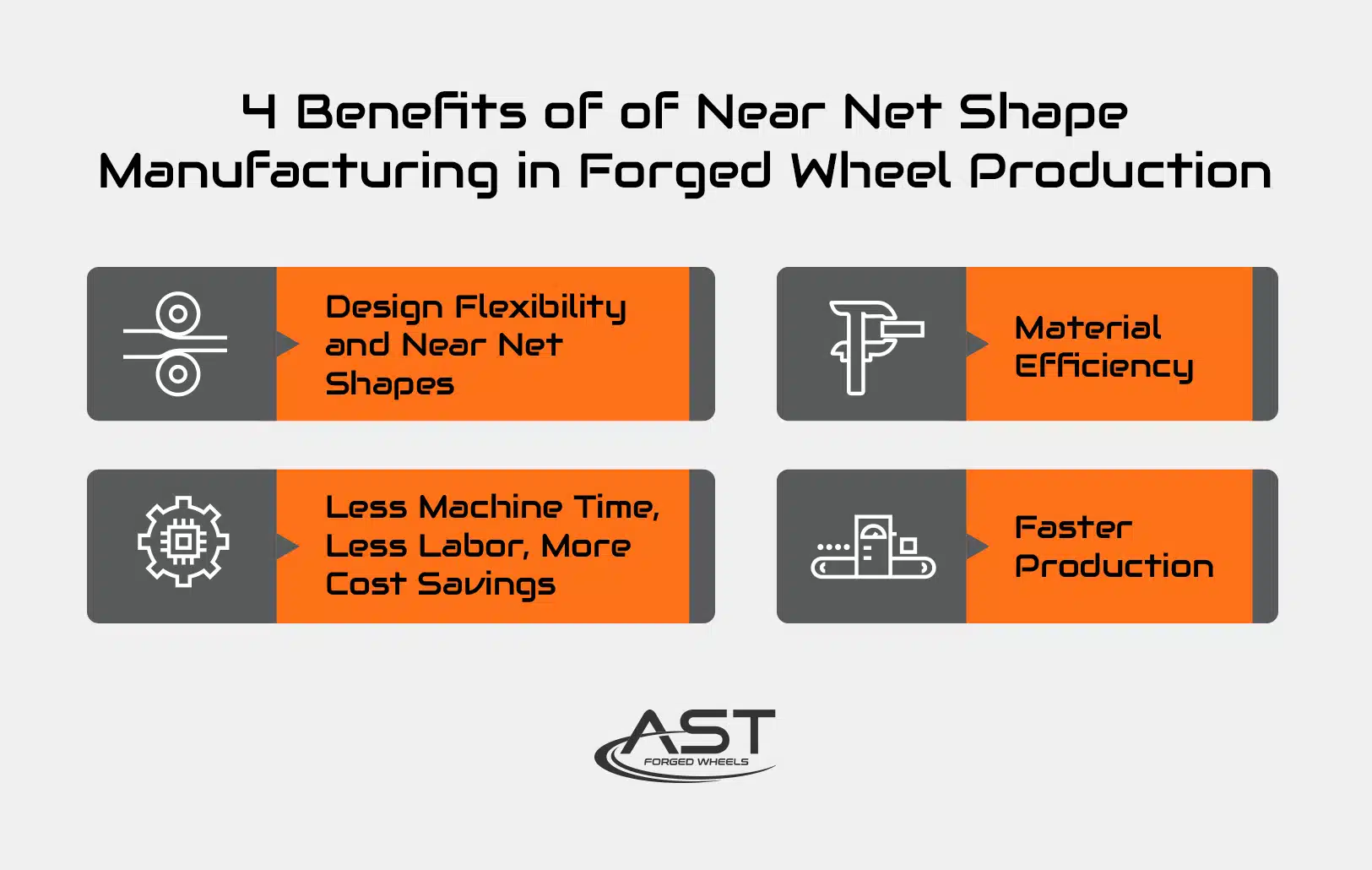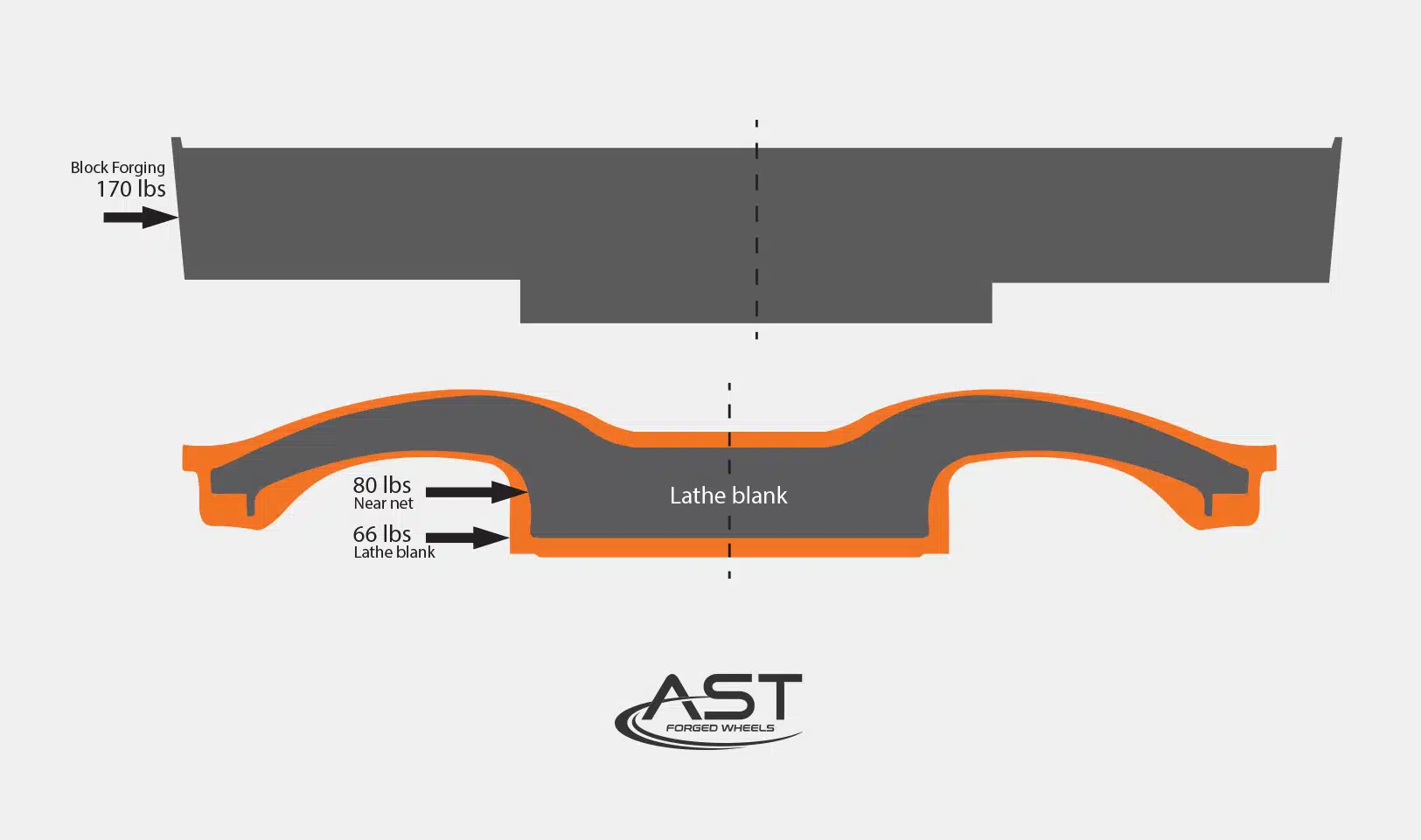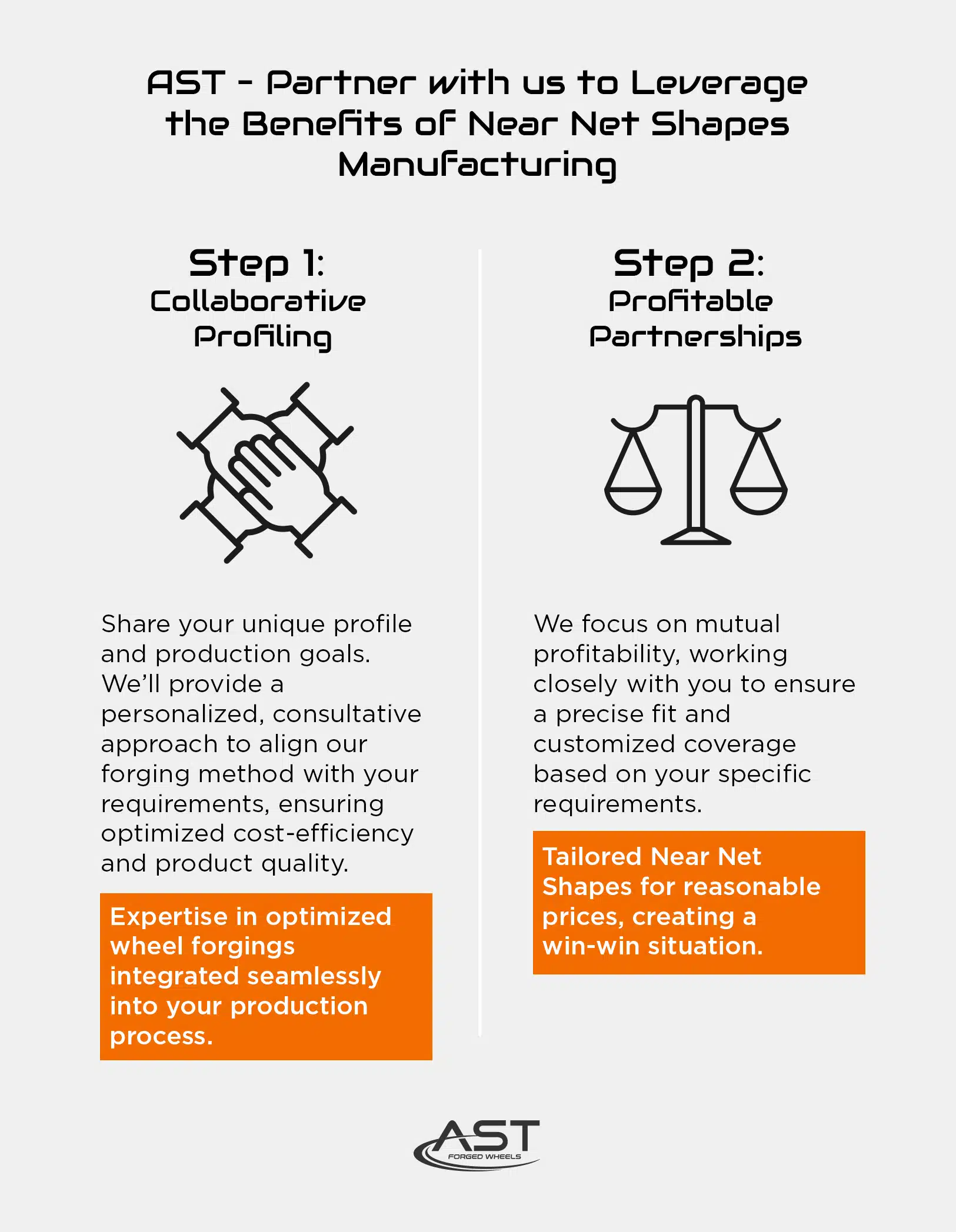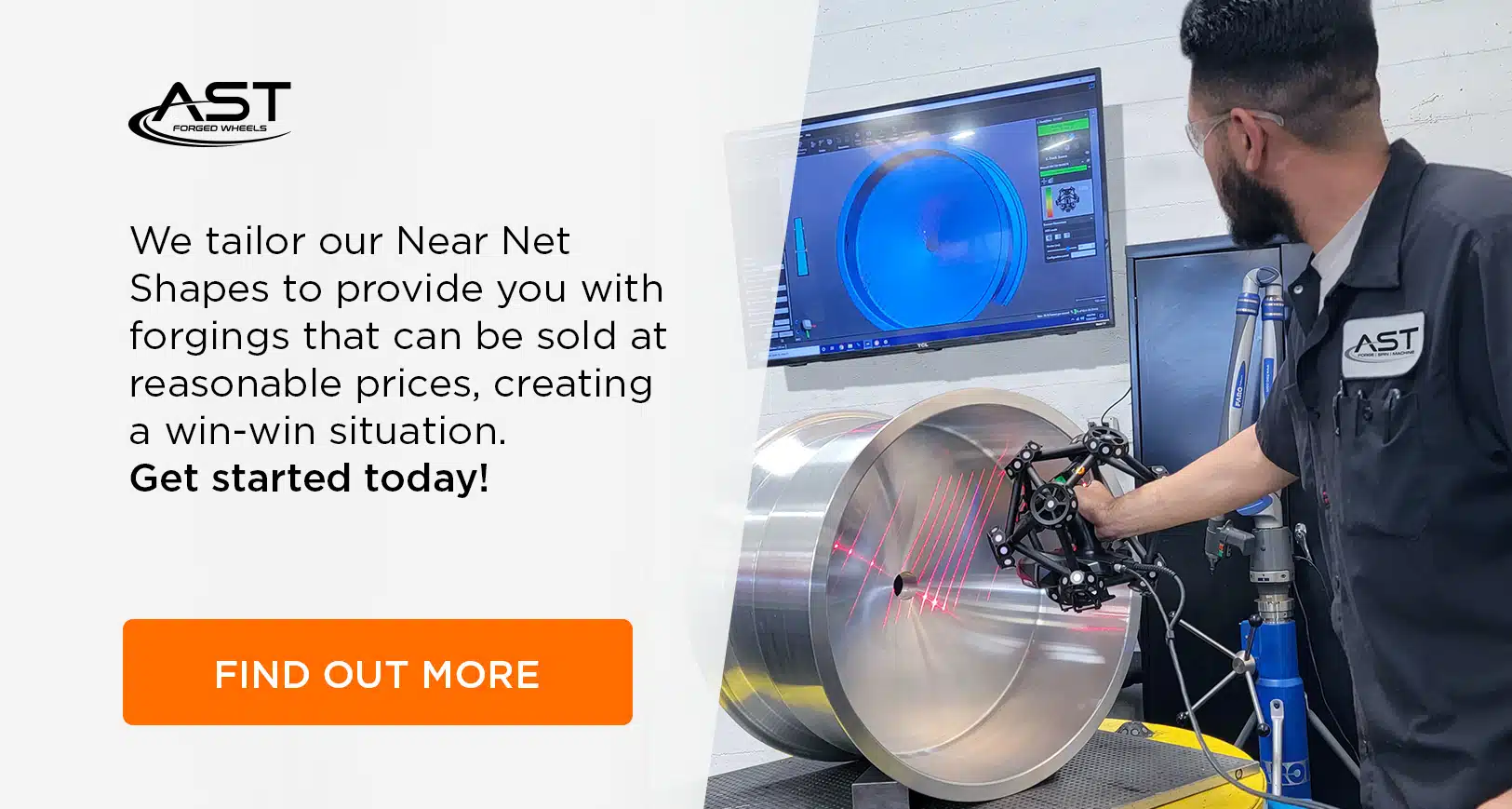What is Near Net Shapes Wheels Manufacturing? Benefits Revealed
 The practice of near net shapes could transform the wheel manufacturing industry, and help wheel manufacturers increase their profit margins.
The practice of near net shapes could transform the wheel manufacturing industry, and help wheel manufacturers increase their profit margins.
Yet, many are still unaware of the far-reaching effects if wheel designers could be guided to only pay for the minimal metal to machine the desired end design of wheels for their customers.
This blog post will delve into its specifics. And uncover its significance in modern wheel manufacturing, where beyond pricing and manufacturing methods, could mean the difference in achieving profit margins.
The knowledge about achieving near net shape production isn’t just about reducing waste and enhancing efficiency – though it does both very well.
It also opens up new possibilities for efficiency in designing a wheel so that those same optimized specifications can be used to increase wheel product offerings to customers of wheel manufacturers.
So let’s dive into the nuances of this approach and its benefits.
What is Near Net Shapes in Wheel Manufacturing?
Simply put, near net shape manufacturing is the practice of planning your production process to make an object as close to its final shape as possible, reducing the time needed to produce a finished item.
For wheel manufacturing, wheel forgings are designed so that they are optimized to a profile very close to the finished product. The closer to the profile means the less excess metal that needs to be removed and then scrapped.
For wheel forgings, you want to produce them to a profile very close to the finished product.
The closer you get to the final profile, the less waste you generate.
This translates to reduced material removal and minimized scrap. Saving precious resources and mitigating financial losses attributed to discarded materials. It is widely known that selling metal scrap will only net you around a half of the cost you spent buying it.
Why don’t More Companies Design Their Wheels to Get Near Net Shapes?
Some companies may be content with a generic starting point, assuming it matches their desired profile.
However, they overlook the considerable loss inherent in using less optimized, block-like forms that don’t align seamlessly with their intended end product.
This hints at a gap in understanding and communication within the industry.
The benefits of Near Net Shapes, in terms of waste reduction and efficiency, might not have reached every corner of the wheel manufacturing world.
Some manufacturers might still be led astray by traditional practices, driven by third-party machine shops that capitalize on scrap accumulation.
However, when considering long-term efficiency gains and potential cost reductions achievable via implementation across all stages – from design planning to final part finishing – taking a closer look at how to achieve near net shapes becomes worthwhile for most producers.
Especially as profitable margins continue to be difficult to achieve for wheel manufacturers.
Advantages of Near Net Shape Manufacturing in Forged Wheel Production
 1. Design Flexibility and Near Net Shapes
1. Design Flexibility and Near Net Shapes
Common wheel forging methods often dictate design possibilities based on blanks manufactured with cost-savings in mind to benefit the producer – not on the most optimized way to reflect the final wheel design for the ultimate end user ─― the customer.
Near net shapes transcend these limitations, offering true design freedom.
By starting with a near net shape, designers are unshackled from predefined molds.
This level of creative autonomy allows manufacturers to craft wheel forgings that align seamlessly with their brand identity and customer expectations.
Manufacturers can now create intricate and captivating wheel designs that were once deemed too complex in terms of utilizing too much excess metal, and having to machine away most of it.
2. Material Efficiency
If you look at vehicles today, their wheels are never just a complete flat face part with a three to six-inch thickness.
The wheel industry has been moving away from conventional flat-face parts and towards more intricate and purpose-driven designs.
Ones that are far more complex.
The common practice in the wheel forging industry is to start with too much metal. A practice that is not ideal for either the wheel manufacturer nor their customer, in terms of cost to purchase the aluminum and then passing the costs onto the customer.
This is where near net shapes practice can optimize results by not machining away excess material and shaping the forging closer to its final intended geometry.
3. Less Machine Time, Less Labor, More Cost Savings
The economic advantages of near net shape forgings extend beyond material savings.
Machine time is greatly lessened when machining a near net forging. The more you can reduce passes at the lathe machine, the shorter machining time, and increased overall production capacity.
When machines work in an efficient process, there is less wear and tear on the equipment; minimizing risk for equipment failure and repair costs, and down time which results in reduction of profit.
4. Faster Production
The time efficiency inherent in near net shape forging is a transformative aspect that could reshape production timelines.
By reducing the need for extensive machining, this allows you to offer finished products faster to anxiously awaiting customers.
Overcoming Challenges in Near Net Shapes Manufacturing
The journey towards mastering near net shapes manufacturing processes can be complex, with various challenges to overcome.
Educating stakeholders about the benefits of near net shape forgings may be the most crucial in immediately realizing results in cost savings for materials and machine time, and increase profit margins. Happy customers will be the ultimate sought after outcome.
Choose AST – Your Next Near Net Shapes Manufacturing Partner
At AST we’ve honed our approach to near net shapes, meticulously refining the forging process to craft components that closely resemble their final shape.
By doing so, we drastically minimize material waste, as our forgings require less machining and material removal.
If you’re a wheel manufacturer looking to leverage the benefits of Near Net Shapes, here’s how you can do it with AST in 2 simple steps.
STEP 1: Collaborative Profiling
Start by sharing your profile with us (talk to sales here).
We understand that every customer is unique.
That’s why we take a consultative approach.
We carefully assess your needs, preferences, and production goals.
This personalized approach ensures that our forging method perfectly aligns with your requirements, optimizing both cost-efficiency and product quality.
We know that many of our clients are experts in unique wheel designs and perhaps not experts in optimized wheel forgings.
We’re here to offer our expertise.
Our goal is to seamlessly integrate near net shapes into your production process.
STEP 2: Profitable Partnerships
Our focus is on mutual profitability.
We work closely with you to ensure a precise fit within the forging and customize coverage based on your specific requirements.
We tailor our Near Net Shapes to provide you with forgings that can be sold at reasonable prices, creating a win-win situation.
Our core belief is that when our customers succeed, so do we.
AST’s approach to Near Net Shapes not only enhances manufacturing efficiency but also aligns with sustainable practices.
FAQs in Relation to Near Net Shapes
What is a near net shape part?
A near net shape part refers to a component that is produced very close to its final dimensions, minimizing the need for additional machining and material waste.
What is near net shape NNS manufacturing?
Near Net Shape (NNS) manufacturing is an efficient production method where parts are made as close as possible to their final form, reducing wastage and enhancing productivity.
What does net shape mean?
‘Net Shape’ means producing a component in its exact final form through initial processing steps without needing significant post-processing or refinement. It maximizes efficiency by eliminating unnecessary operations.
What is near net shape in wheel blank manufacturing?
Optimizing the materials needed to produce the desired final design.






